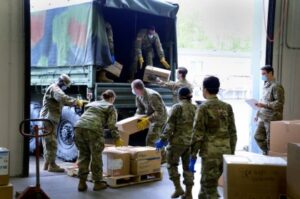Disagreement About What It Accomplished

Oregon Army National Guard soldiers with Task Force Assurance prepare boxes of personal protective equipment and load them for local distribution as part of the COVID-19 response in April 2020. DoD photo
WASHINGTON, DC — Next month marks the 5-year anniversary of the first case of COVID-19 reported in the United States. Since then, more than 110 million Americans have been infected, and 1.2 million have died. While the virus continues to circulate, with infection rates predicted to rise again following the holidays, legislators are anxious to move on.
Last month saw the final scheduled meeting of the House Select Subcommittee on the Coronavirus. Formed in April 2020 and tasked with overseeing the government’s response to the pandemic, the subcommittee is being allowed to sunset. During its existence, the subcommittee held 25 hearings, sent 118 investigative letters, conducted 38 transcribed interviews and reviewed more than 1 million pages of documents.
What the group accomplished over the last 4 years depends on which member you ask.
According to Chairman Rep. Brad Wenstrup (R-OH), the subcommittee exposed “serious flaws in the government’s response to the pandemic.” Ranking Democrat Rep. Raul Ruiz (D-CA) argues that, under Republican leadership, the subcommittee wasted its time promoting misinformation and pursuing vendettas against scientists when it could have been preparing the nation for a future pandemic.
While previous hearings might have been focused on dissecting the past, the topic of the final hearing was the future and what gaps still exist in the nation’s pandemic preparedness system. The general consensus among experts from CDC, FDA and HHS was that many of the gaps that caused such difficulties in 2020 are still present, most prominently the medical supply chain.
Hilary Marston, MD, MPH, FDA’s chief medical officer, stressed the fragility of that chain, as evidenced not only by COVID-19 but by outbreaks of avian flu and recent hurricanes.
“We need greater transparency into supply chains to help ensure access into critical medical products,” Marston said. “These shortages are incredibly painful for communities across the country. They are not a new problem, but they were certainly highlighted by the COVID pandemic.”
She highlighted generic sterile injectables as an example of a serious weakness in the chain.
“Not everybody can make them,” she explained. “They need to be sterile. They can’t be made everywhere, and they require additional upkeep of those [supply lines], additional care, the ability to have buffer stocks. This all costs money, and profit margins [for these drugs] are really thin.”
Another source of concern for FDA are medical-device manufacturers, Marston said. These companies are not required to inform the agency of any supply-side disruptions outside of a national emergency, such as when a factory is destroyed by a weather event. This can result in sudden, unexpected shortages that FDA and hospitals don’t see coming.
One supply system weakness highlighted by COVID-19 was the ability to buy enough personal protective equipment (PPE). As hospitals’ normal supply chains were cut off or delayed, they resorted to other PPE sources, some of which turned out to be fraudulent. This problem extended through private and federal healthcare systems.
In particular, VA fell victim to a number of bad actors that took advantage of the department’s PPE crisis during the early days of the pandemic, and the department is still mopping up the fallout. In recent months, a California company was charged with conspiring to sell misbranded N95 masks. A Florida company was charged with a similar scam, and another Florida company that won a contract to supply VA with PPE was charged with sending nonconforming equipment and counterfeit medical masks.
Other federal agencies were unable to purchase PPE swiftly and had to funnel their purchases through DoD.
“I’m concerned that, still, the Department of Health and Human Services does not have the same emergency buying power that the DoD has,” Rep. Robert Garcia (D-CA) told the panelists. “When we went through the pandemic, much of the purchasing of PPE and testing went through DoD, because they had emergency power to purchase in bulk and cut the red tape. That does not exist for HHS, which I believe is where those purchases should be coming from.”
Garcia said he is working on crafting legislation to address that problem.
As with previous hearings, part of the time was taken up with finger-pointing and revisiting hot-button issues, such as vaccine mandates and whether current vaccine hesitancy can be laid at the feet of poor communication by federal agencies during the height of the pandemic or the amplifying of scientific misinformation by Republican legislators.
The officials on the panel declined to assign blame but testified that distrust of vaccines has cost lives in the last 5 years and is a source of concern for the future.
“I remember when I was in the emergency operation center in 2000 watching deaths climb and then, when vaccines became available, I saw rates go down. It was tremendous. It was magnificent,” described Henry Walke, MD, MPH, CDC’s director of the Office of Readiness and Response. “But when the distrust and miscommunication around vaccines started, we saw death rates plateau.”
He added that “federal agencies can only do so much.”

